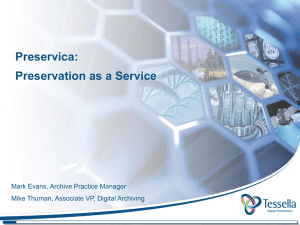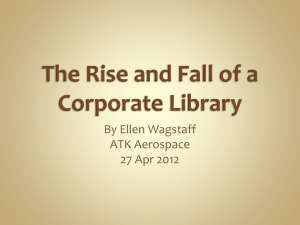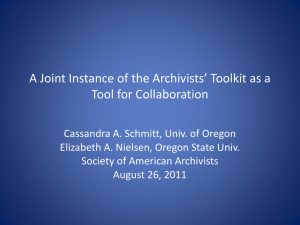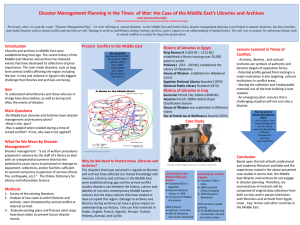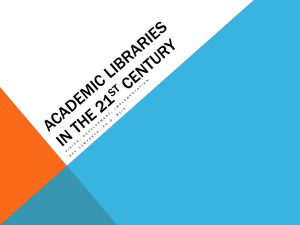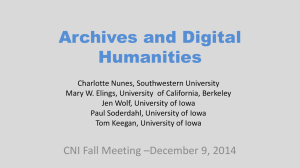Using Time Lapse Photography to Assess the Library
advertisement
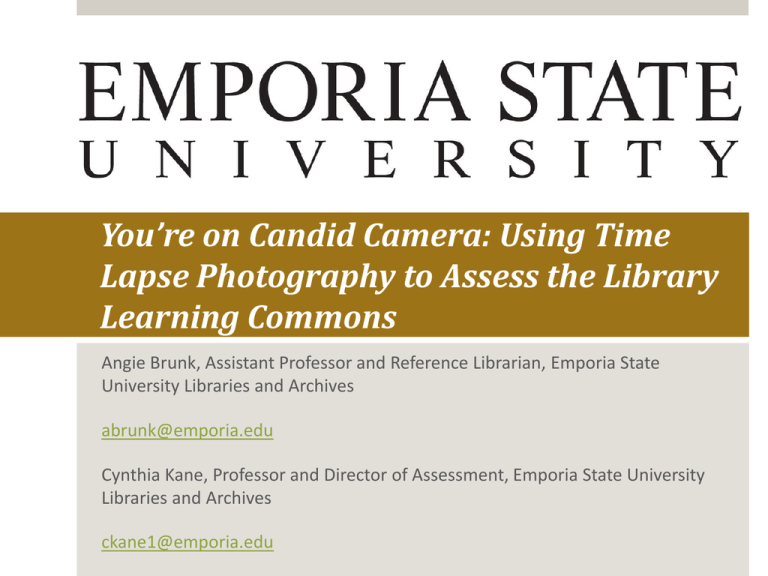
You’re on Candid Camera: Using Time Lapse Photography to Assess the Library Learning Commons Angie Brunk, Assistant Professor and Reference Librarian, Emporia State University Libraries and Archives abrunk@emporia.edu Cynthia Kane, Professor and Director of Assessment, Emporia State University Libraries and Archives ckane1@emporia.edu How did we get here? Some background about ESU and the Libraries and Archives Emporia State University: Part of Kansas Board of Regents system Fall 2013: 3873 undergraduate students; 2160 graduate students (includes full-time and part-time students) Four schools/colleges:Liberal Arts and Sciences; School of Business (AACSB accreditation); School of Library and Information Management (ALA accreditation); Teachers College (NCATE accreditation) Carnegie Basic Classification: Master’s L: Master’s Colleges and Universities (larger program) And…we are preparing for our Higher Learning Commission site visit (March 23-25, 2015)! How did we get here? Some background about ESU and the Libraries and Archives ESU Libraries and Archives (ULA) William Allen White Library (focus of this study) and the University Archives 8 full-time ULA librarians with University faculty status and rank Recently switched to WorldCat WMS for online catalog, acquisitions, circulation, and technical services Focus in the last academic year upon student learning outcomes for decisions about physical remodeling of the library building, acquisition of resources, and changing services (for example, combining Reference and Circulation into Public Services) Assessment and William Allen White Library Director of Assessment: Relatively new position as of Spring 2014 to concentrate specifically upon all aspects of ULA services, resources, and teaching in regard to outcomes. Assessment projects include: iSkills (2012/13 academic year) and Project SAILS (2013/14 academic year): Used in our UL100, Information Literacy and Technology credit course for standardized information literacy assessment LibQUAL+: Administered in Fall 2010 and Spring 2013 to gauge Minimum, Desired, and Perceived satisfaction with Library as Place, Information Control, and Affect of Service One outcome from LibQUAL+…and how to assess success? LibQUAL+ in 2010 and 2013: Undergraduate students increasingly were using the library building as a physical space and place for group and individual study. Desire expressed in comments for a 24/7 space equipped with computers and printers (not so much for traditional library services such as reference and circulation) Along with statements from ESU Associated Student Government for a “commons” space in the library, an extensive remodeling in 2010 and 2011 of the Memorial Union proved that enhancements of physical spaces were attractive to students! So, in summer 2012 WAW Library began… A Learning Commons! (insert photo) Success, but how to measure it? What we wanted to know When are students using the area? What are they doing? How long are they staying? Are they moving furniture? Are they using different areas for different activities? How are students distributing themselves? Are students turned away by the swipe system? Document the remodel Methods used One or two questions surveys of students who swipe in after hours Time lapse photography Our set-up Tripod Brinno Wide angle time lapse camera with moveable lense Post processing done in iMovie Cost less than $200 Ethics There is no reasonable expectation of privacy in a public place Students have to swipe in after normal hours The camera is visible and static so students can Avoid it Move it The set-up is generally not sufficient resolution and/or focus to capture confidential information in meaningful detail. We decided against shooting our relaxation station Questions we asked How often should we do this? When Where? How often should we post the videos to social media? Which videos make good social media posts and which are purely data? Things we learned in the first year You are going to have to experiment to really learn what questions you can answer in your space with your equipment. You are going to have to experiment with timing intervals depending on the data you are trying to capture When you encourage students to move the furniture they will Move the camera Move furniture so it blocks the camera Typical settings For task oriented, slightly less time than the task For general data gathering every 5 to 15 minutes depending on the recording interval. When Early in the semester Mid-terms Dead week Finals week Tried shooting a couple of events—this was better captured with standard photography Pros and Cons of locations Learning Commons North had too many walls, moveable walls and divided spaces to get a good view of the whole thing. Thin Client banks hard to see the whole thing Learning Commons South had the best angle, best light and most open space. Also happens to have majority of student activity What data can we capture Good for capturing patterns and the big picture Are student moving furniture? Are people visiting an archives exhibit when the rest of the archives is closed? What are students doing in the learning commons? We might also try Using it to monitor interactions at the combined services desk Limitations Great for big picture but not for small details Events may not be kept in context You can’t keep the same view throughout the recording period The set-up is not subtle Other uses Tremendous success with social media Over 1000 views of the first video we posted to facebook Visual evidence of what is going on can easily be presented to stakeholders such as the administration and student government. Lessons Learned and Next Steps! Interest in a wider ethnographic study of WAW Library physical space; see: ERIAL Project University of Rochester Undergraduate Research Project, Studying Students How does our time-lapse photography fit into those contexts? As noted earlier: How can time-lapse photography be utilized in other library space contexts? 1st floor: Currently set up as collaborative study area with movable whiteboard partitions 4th floor: Designated as “quiet study” area and will continue to be open space for individual use



